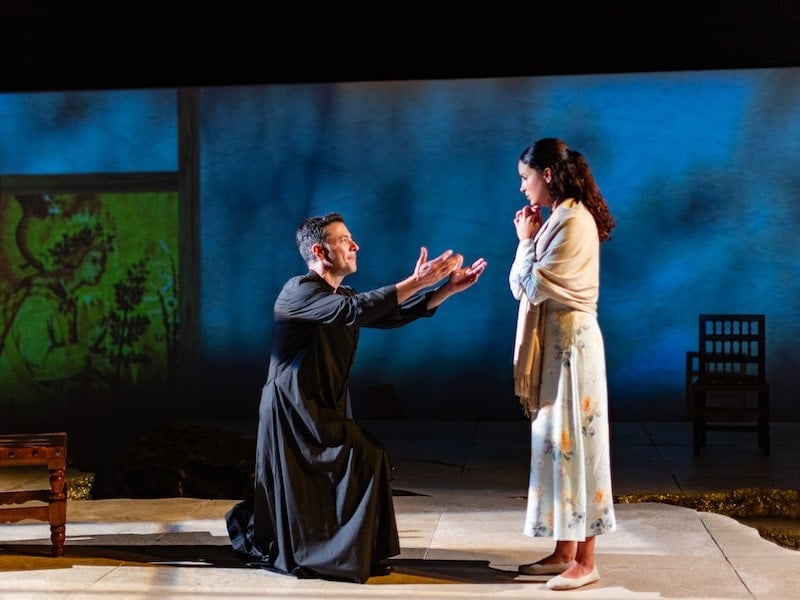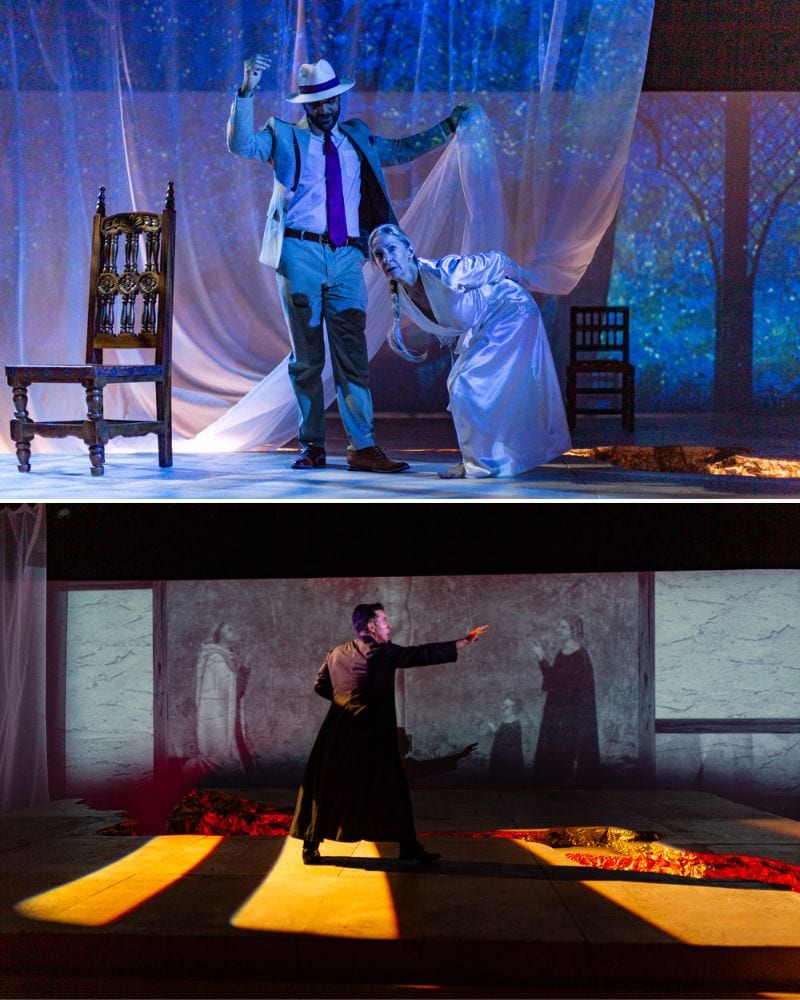Will they or won’t they? That’s the plot template for innumerable romantic comedies and dramas. Two people meet and fall passionately in love. There are obstacles. Can the couple overcome the obstacles and have a life together or will they regretfully part?
In Bathing in Moonlight (Baño de luna), directed by playwright Nilo Cruz at DC’s GALA Hispanic Theatre, the obstacle is that Father Monroe (Raul Méndez) is a Catholic priest. Falling in love with Marcela (Hannah Guillén) and becoming part of a couple will result in him losing his vocation, a matter of great anguish to both.

Marcela, her mother Martina (Luz Nicolás), her brother Taviano (Hiram Delgado), and her teenage son Trino (Victor Salinas) are exiles from Cuba. The emotional currents among them create a never fully resolved family drama that exists alongside, but is not fully integrated with, the play’s central romantic drama.
Marcela is an evidently concert-quality pianist. She and Martina sold her Steinway to finance Taviano’s medical education in the Dominican Republic. Marcela practices classical pieces on a piano at Father Monroe’s church, where he is drawn to her initially through her music, itself a spiritual connection.
Taviano returns home after being out of contact for two years, having flunked out of medical school. Martina, who slips in and out of lucidity, sometimes imagines Taviano to be her long-dead husband, Tavio (also played by Delgado).
The scenes involving Tavio and Martina are among the most lyrically touching in the play. As they enter, he pulls a gauzy, sheer curtain at an angle onto the stage. He is the dashing young man she remembers; she, elderly in body, lives in the spirit of her younger self, swept away by love, beautifully costumed by Cidney Forkpah in a satiny white gown and white veil. Forkpah also makes good use of hats, which have an important physical and symbolic role in the play.
For me, Martina is the most interesting character in the play. She exemplifies the loneliness of exile. She also has a bit of a Tennessee Williams character in her, having insisted, to the detriment of the family, on retaining the trappings of her former affluence while living in straightened circumstances in the U.S.
Father Monroe’s dilemma is between his devotion to his role as a priest — he’s really good at it — on one hand, and on the other his feelings for Marcela, which she returns, opening for him a dimension of love — God’s love and human love — that he has not before experienced.
His foil, Bishop Andrews (Carlos Castillo), argues in a prolonged second-act scene that Father Monroe must abandon his love for Marcela to be true to God and his vows. While not unsympathetic to Father Monroe’s situation, Bishop Andrews, representing the Church, is unbending: the priest must leave the woman he loves or end his ministry. Either way, Father Monroe will lose something he cherishes.

Under Cruz’s direction, the acting style of the thoroughly competent cast is one of consistently high emotional intensity. What really makes the play sing, though, is its excellent physical production. Clifton Chadick’s set is based on a three-tier rectangle, the upper level of which is creased by an irregular fissure, suggesting a weakness, a break in the confines of the rectangles. On three sides, the platforms are surrounded by large rectangular screens on which Hailey Laroe’s superb projections are displayed.
The shapes do not seem accidental. The history of the family, and the strictures of the Church, exist within the rectangles. When the projections depict a church setting, the religious paintings shown are themselves rectangles, often mingled with what looks like chain link fencing. In other scenes, the projections show open, natural settings, like woods on a magical night, a vision of the open human hearts with which the play is concerned.
While Cruz makes good use of the aisles (and in one case a balcony) for actors’ entrances, much of his blocking is rectilinear, notably in a second-act family conflict scene as Martina paces rapidly around three sides of the set while Taviano vents his anger at her. When Father Monroe crosses the chasm and walks in a somewhat diagonal direction toward his final exit, it is a meaningful movement.
Priests contemplating leaving the Church to get married and form a human family is not — as Bishop Andrews himself notes — a new thing. But Bathing in Moonlight expresses well the difficulty of the profound emotions for everyone involved in such a choice.
Running Time: Two hours and 15 minutes, including one intermission.
Bathing in Moonlight (Baño de luna) plays through October 1, 2023 (Thursdays to Saturdays at 8 p.m., Sundays at 2 p.m.), at GALA Hispanic Theatre, 3333 14th Street NW, Washington, DC. Purchase tickets online. Regular tickets are $48 from Thursday through Sunday. Senior (65+), military, and group (10+) tickets are $35; and student (under 25) tickets are $25. Noche de GALA tickets are $55 each. For more information, visit galatheatre.org or call (202) 234-7174. Tickets are also available on Goldstar and TodayTix.
In Spanish with English surtitles.
The playbill for Bathing in Moonlight is downloadable here.
COVID Safety: All performances are mask-optional. See GALA’s complete COVID-19 Safety Policy.
SEE ALSO:
Nilo Cruz on love, compassion, and ‘Bathing in Moonlight,’ at GALA (interview by Deryl Davis, September 4, 2023)




